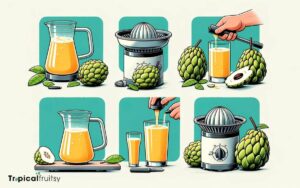What Is a Custard Apple? Discovering the Sweet Secrets!
Custard apples, or cherimoyas, are tropical fruits celebrated for their smooth, sweet taste and creamy texture, reminiscent of a blend of various fruits.
Originating from the West Indies and South America, they may appear unassuming with their rough green skin, yet inside lies a luscious, custard-like pulp interspersed with black seeds.
Beyond their delightful flavor, custard apples are a treasure trove of nutrients, boasting a wealth of vitamins, minerals, and antioxidants.
They’re versatile in use, enhancing everything from fresh fruit plates to desserts and smoothies. For those interested in cultivation, they thrive in a tropical climate and demand attentive care.
When it comes to storage, ripe custard apples can be refrigerated for a short period, maintaining their quality.
The custard apple, also known as cherimoya, is a sweet tropical fruit with a creamy texture and a flavor often described as a blend of banana, pineapple, and papaya.
It has a distinctive knobby green exterior and a soft, segmented interior filled with black seeds. Custard apples provide a variety of health benefits due to their rich content of vitamins, minerals, and antioxidants.
Custard apples are native to parts of Central America, the Caribbean, and South America. They are eaten fresh, used in desserts, and are a popular ingredient in smoothies.
Here are some key points about custard apples:
Custard apples are a delectable and wholesome addition to any diet, offering a unique taste and numerous nutritional benefits.
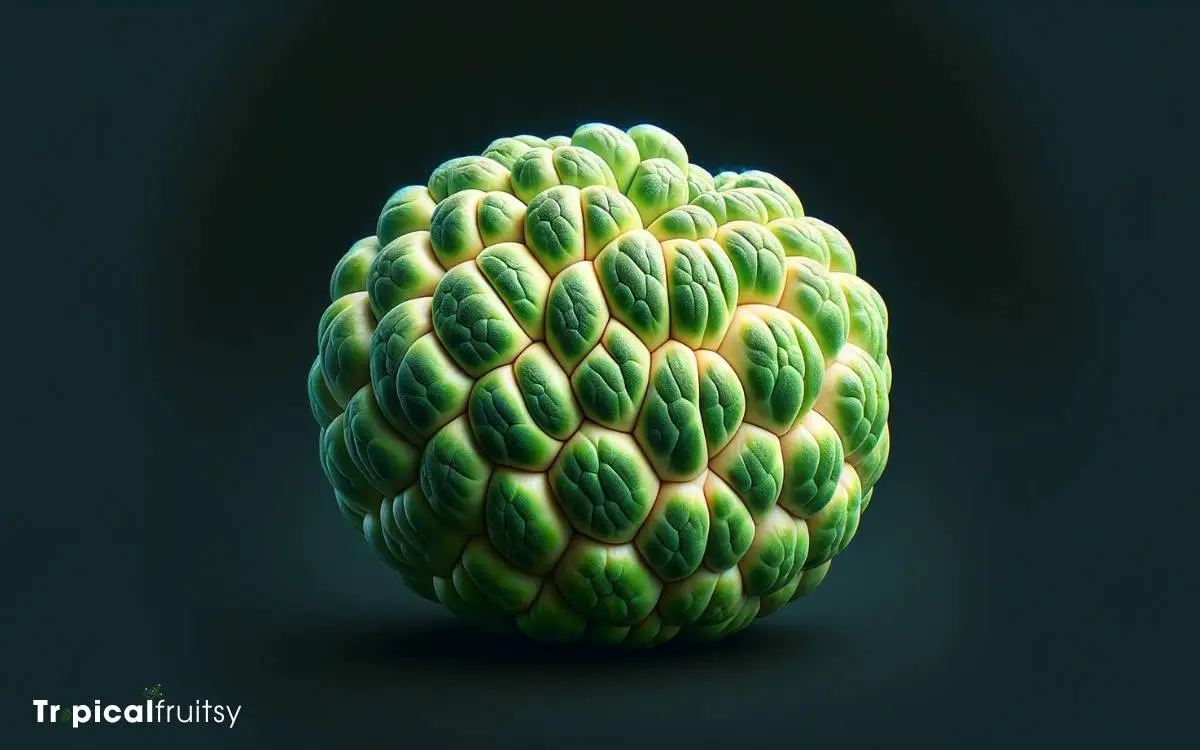
Key Takeaway
Nutritional Benefits of Custard Apples
| Nutrient | Benefit |
|---|---|
| Vitamin C | Boosts the immune system, promotes skin health |
| Dietary Fiber | Aids in digestion and can help regulate blood sugar levels |
| Antioxidants | Protects against free radical damage, may reduce the risk of chronic diseases |
Origins and History

The custard apple’s lineage traces back to the tropical rainforests of South America, where I’ve learned it’s been cherished for centuries.
Analyzing its botanical journey, I’ve found that the custard apple, or Annona reticulata, is part of the Annonaceae family, which is notable for species rich in compounds with potential health benefits.
This fruit’s proliferation from its native habitat to different parts of the world underscores its adaptability and the value placed on its unique flavor profile and nutritional content.
Through seed dispersal and human cultivation, it has spread to various tropical regions.
Its growth pattern, requiring a warm, humid climate, aligns with the conditions of its original ecosystem, allowing it to flourish outside South America in similar environments, further emphasizing its resilience and enduring appeal.
Physical Characteristics
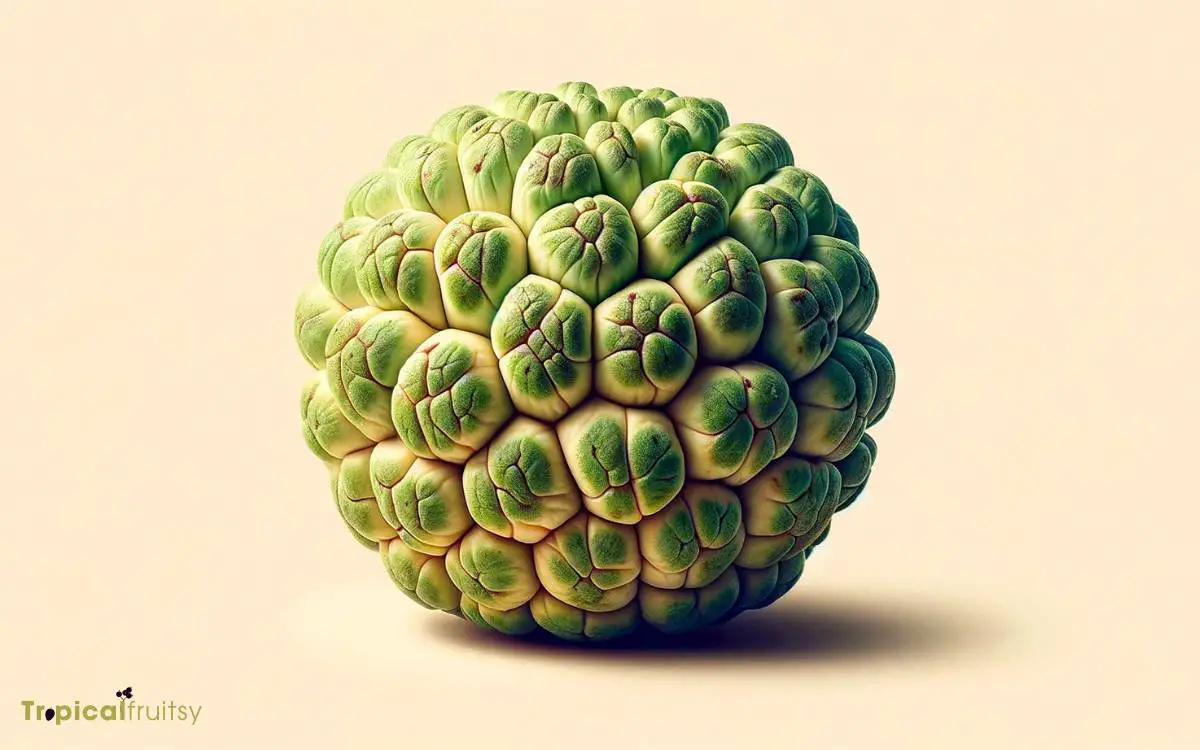
Custard apples boast a unique, heart-shaped form with a bumpy, green exterior that yields to a creamy, white flesh when ripe.
Let’s delve into their physical attributes with precision:
| Aspect | Description | Remarks |
|---|---|---|
| Shape | Heart-shaped | Conical to round at base |
| Skin Texture | Bumpy and segmented | Thicker at maturity |
| Color | Green, varying to yellowish with ripeness | Darker shades when unripe |
Their skin, while coarse to the touch, encases a flesh that’s not just succulent but also interspersed with a network of inedible, black seeds.
The seed-to-pulp ratio is a crucial characteristic that influences the fruit’s edibility and culinary applications.
Analyzing its cross-section, we observe a soft, granular texture that’s enveloped by a thin, yet robust peel. This structural complexity is what gives the custard apple its distinctive mouthfeel and palatability.
Nutritional Profile
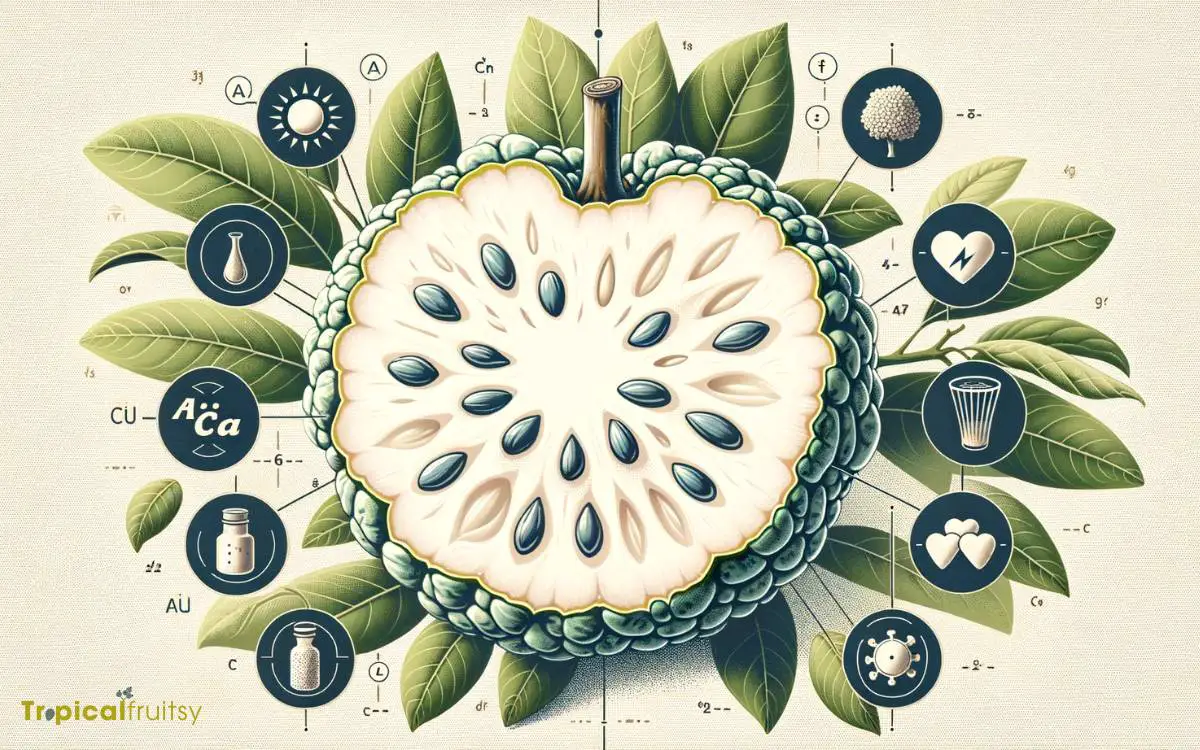
Turning to the nutritional profile of the custard apple, I’ll examine its vitamin content and caloric value to provide a clear understanding of its dietary significance.
Its vitamin composition is particularly noteworthy, with a rich presence of vitamin C and various B vitamins which play crucial roles in maintaining bodily functions.
Analyzing its caloric value, I find that the custard apple offers a moderate energy yield, making it a suitable inclusion in a balanced diet.
Vitamin Content
In examining the nutritional profile of a custard apple, I’ve found that it’s particularly rich in vitamin C and several B vitamins.
The vitamin C content is noteworthy, as this antioxidant plays a pivotal role in immune function and skin health.
Additionally, the B vitamins present, including thiamine (B1), riboflavin (B2), niacin (B3), and folate (B9), are crucial for energy metabolism and maintaining proper nerve function.
The fruit’s folate content is especially significant for pregnant women, as it’s essential for fetal growth and development.
These vitamins, together with their associated micronutrients, contribute to the overall dietary value of custard apples.
Caloric Value
Regarding the energy content of custard apples, I’ve discovered that they provide a moderate amount of calories, making them a suitable choice for an energy-boosting snack.
On average, a custard apple contains about 94 kilocalories per 100 grams. This caloric value stems primarily from its carbohydrate content, which is the fruit’s main macronutrient.
- Carbohydrates: Approximately 23.64g per 100g, primarily consisting of natural sugars and dietary fiber.
- Protein: Provides about 2.06g per 100g, a modest but valuable contribution to daily intake.
- Fats: An insignificant amount, roughly 0.29g per 100g, making it low in fat.
- Dietary Fiber: Offers about 4.4g per 100g, contributing to satiety and digestive health.
Analyzing these figures, I find that custard apples are a balanced source of energy and nutrients.
Culinary Uses
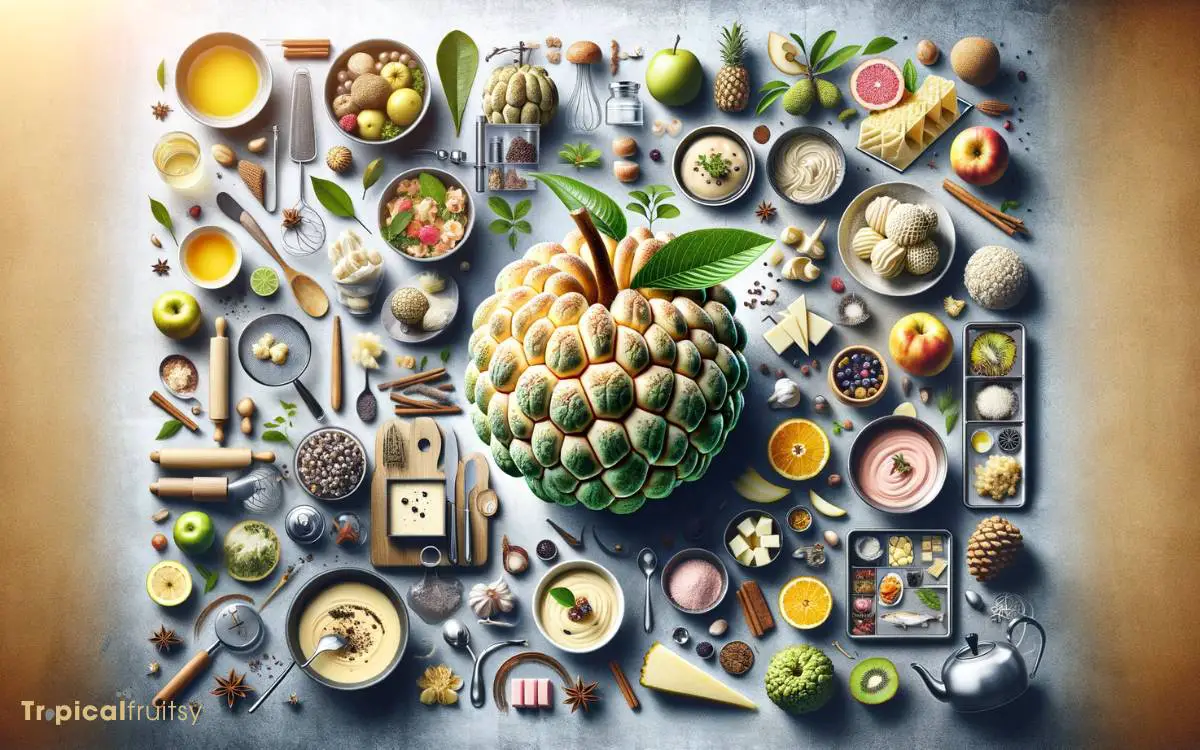
I often incorporate custard apples into desserts and smoothies for their creamy texture and sweet flavor. The fruit’s high moisture content and natural sugars make it an ideal component for a variety of sweet preparations.
In my analysis, I’ve found that when blending custard apples for smoothies, it’s essential to strain the pulp to remove the seeds, which are inedible and can impart a bitter taste.
Technically, the fruit’s flesh can be used as a fat substitute in baking due to its smooth consistency, which also adds natural sweetness, reducing the need for added sugars.
Detailed recipes may call for custard apple puree in cheesecakes or mousses, where its subtle, tropical notes complement other flavors without overwhelming the palate.
Health Benefits
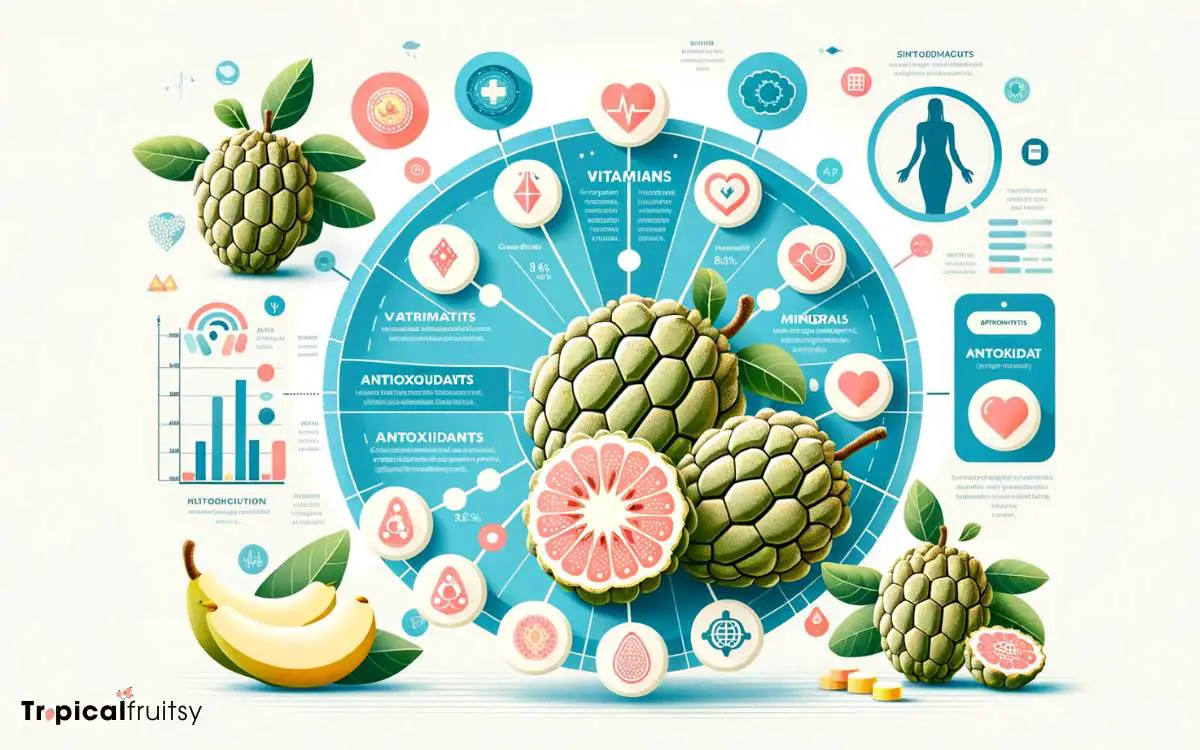
Custard apples not only delight the palate but also offer a wealth of health benefits, including essential vitamins and minerals that support overall well-being.
My analysis of its nutritional profile reveals several key advantages:
- High in Vitamin C: Acts as an antioxidant, enhancing immune function and skin health.
- Rich in Dietary Fiber: Aids in digestion and helps maintain a healthy gut, potentially reducing the risk of certain digestive disorders.
- Contains Potassium: Regulates blood pressure and heart function, contributing to cardiovascular health.
- Magnesium Source: Supports nerve function and bone health, and plays a role in energy metabolism.
These components showcase custard apples as a potent health ally.
Growing and Harvesting

While the health benefits of custard apples are significant, it’s also essential to understand how to cultivate and harvest these fruits for optimal quality.
I analyze the soil pH requirements, which should range between 6.5 and 7.5 for ideal growth conditions. I ensure that the trees are planted in well-draining soil to prevent root rot, a common issue in poorly drained areas.
| Factor | Description |
|---|---|
| Climate | Requires tropical or subtropical climate, avoiding frost |
| Soil | Deep, rich in organic matter, pH 6.5-7.5 |
| Watering | Regular during growth, reduced before harvest |
| Pruning | Essential for shaping the tree and removing dead wood |
| Harvesting | Handpicked when fruits are plump, yielding slightly to gentle pressure |
Purchasing and Storage Tips
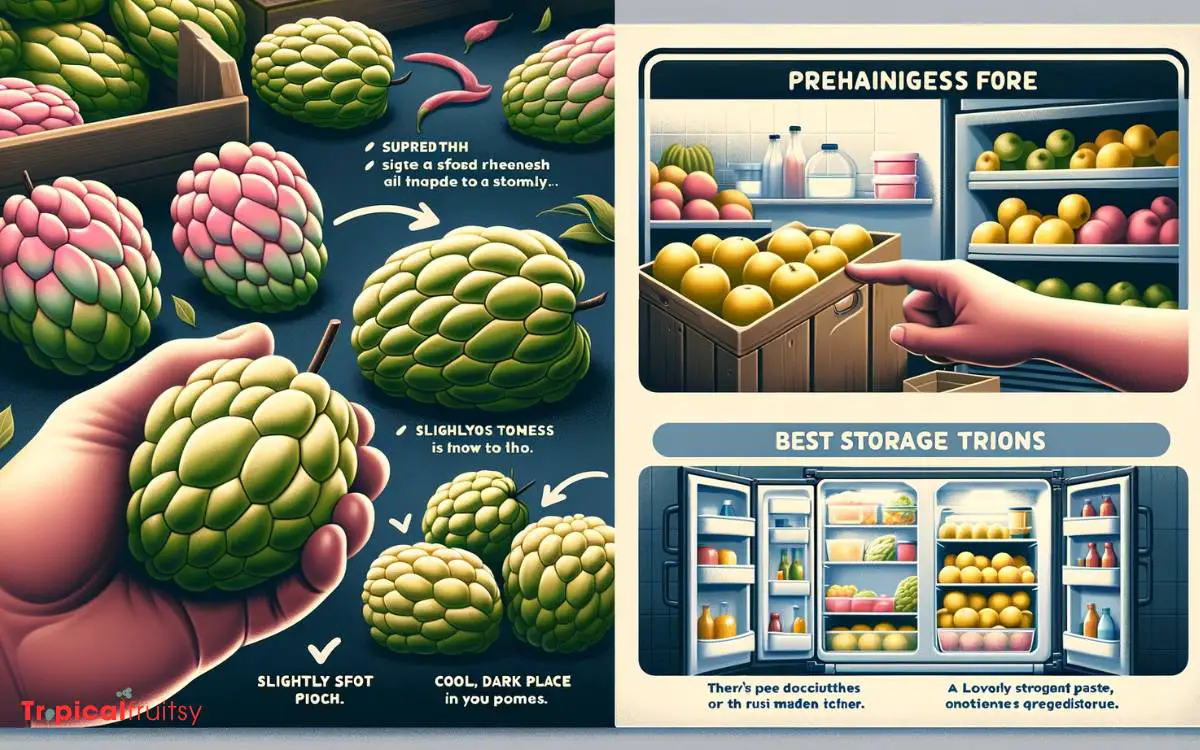
When I look for custard apples at the market, I assess their ripeness by checking for a slight give upon gentle pressure, ensuring I’m purchasing fruit at its peak flavor profile.
I’ve found that optimal storage conditions are crucial; custard apples should be stored at room temperature until they reach full ripeness and then refrigerated to slow down the ripening process.
In my experience, careful attention to these details can significantly extend the fruit’s shelf life and maintain its desirable texture and taste.
Selecting Ripe Fruit
In choosing a ripe custard apple, I look for a fruit that yields slightly to gentle pressure, ensuring it’s at the peak of its sweetness and ready to be enjoyed.
There are specific indicators I consider:
- Skin Texture: I check for a skin that’s bumpy but not overly hard; overfirmness can indicate under-ripeness.
- Coloration: I seek out fruits that have a consistent color, with hints of yellow or brown, which typically denote ripeness.
- Fragrance: A mature custard apple emits a subtle, sweet smell; any strong, fermented odor may suggest over-ripeness.
- Stem Area: I examine the area around the stem; it should give in slightly under pressure if the fruit is ripe, indicating the internal flesh is soft and creamy.
Optimal Storage Conditions
After I’ve selected a ripe custard apple, I ensure it stays fresh by storing it at room temperature until it’s fully ripe, then moving it to the refrigerator.
This transition is crucial because custard apples, like many climacteric fruits, experience a peak in ethylene production, which stimulates ripening.
At room temperature, this process unfolds naturally, but once the fruit reaches its peak ripeness, refrigeration slows down enzymatic activity and decay.
I carefully wrap the fruit in a perforated plastic bag to balance humidity and prevent moisture accumulation that can lead to spoilage. Ideally, custard apples should be consumed within a couple of days once refrigerated.
When I’m ready to eat the fruit, I let it readjust to room temperature for optimal flavor and texture.
Another Name for Custard Apple
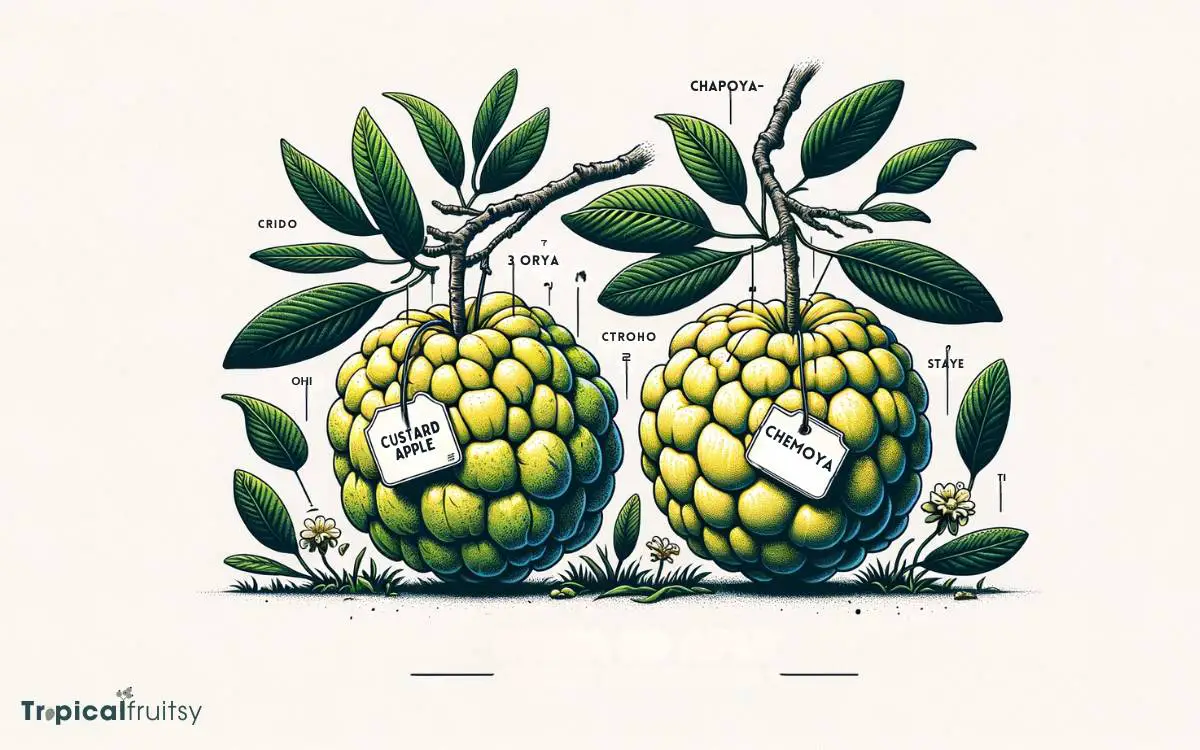
Custard Apple, also known as Cherimoya, is a tropical fruit known for its creamy texture and sweet, complex flavor. It is scientifically referred to as Annona cherimola and belongs to the Annonaceae family.
Here are more details about this unique fruit:
Origin and Distribution: Cherimoya is native to the Andes Mountains in South America, particularly in countries like Ecuador, Colombia, Bolivia, and Peru.
Its cultivation has spread to other parts of the world, including California and Florida in the United States, Southern Europe, Northern Africa, and some parts of Asia and Australia.
Physical Description: The fruit is heart-shaped, often slightly irregular due to its segmented skin. The skin is green and leathery, with a scaly appearance. The size of the fruit can vary but generally ranges from 10 to 20 centimeters in diameter.
Taste and Texture: The flesh of the cherimoya is creamy and soft, similar to that of custard, hence the name “Custard Apple.”
The flavor is a delightful blend of banana, pineapple, papaya, peach, and strawberry. Some people also detect subtle hints of vanilla or coconut.
Nutritional Value: Cherimoya is rich in vitamins and minerals, particularly vitamin C, vitamin B6, riboflavin, and potassium. It’s also a good source of dietary fiber and contains antioxidants.
Culinary Uses: The fruit is primarily eaten fresh. The flesh can be scooped out with a spoon and consumed directly, avoiding the large black seeds, which are toxic if crushed and ingested.
Cherimoya is also used in smoothies, fruit salads, desserts, and ice creams.
Growing Conditions: Cherimoya trees prefer mild climates with high humidity. They are sensitive to extreme temperatures, particularly frost, which can damage the tree and fruit.
Propagation and Harvesting: The tree is typically propagated through seeds, although grafting is also common for commercial cultivation. The fruit is handpicked from the trees when mature and softens upon ripening.
Health Benefits: Cherimoya has several health benefits, including boosting the immune system, improving heart health, and aiding digestion.
Its high vitamin C content is great for skin health, and the dietary fibers help in maintaining good digestive health.
The Custard Apple or Cherimoya is a delicious, nutritious fruit with a rich cultural and agricultural history. Its unique flavor and creamy texture make it a favorite in many parts of the world where it is grown and consumed.
What Is a Custard Apple Tree
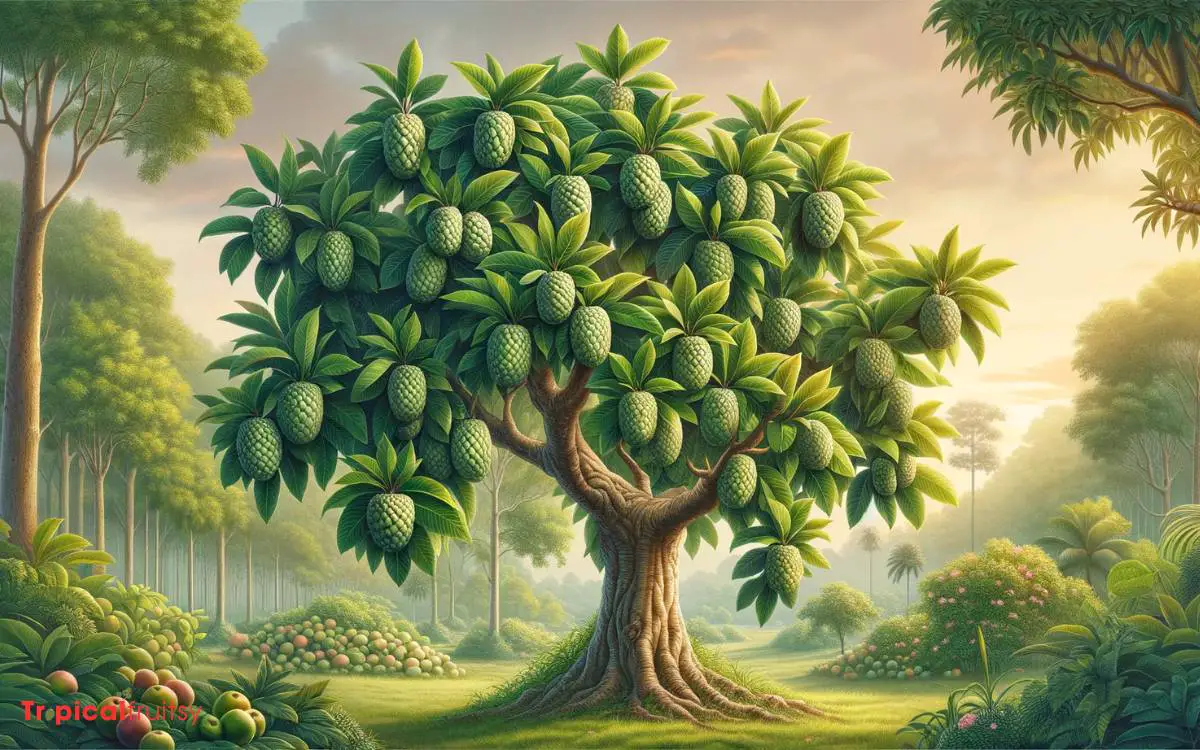
A Custard Apple tree, scientifically known as Annona reticulata, is a tropical tree that produces the Custard Apple fruit, also known as Bullock’s Heart.
It’s part of the Annonaceae family, which includes other fruits like Cherimoya, Soursop (Graviola), and Sugar Apple (Sweetsop).
Here are key details about the Custard Apple tree:
Physical Characteristics: The Custard Apple tree is a small to medium-sized tree, typically growing up to 15-35 feet tall.
Its leaves are thin, oblong or lanceolate, and light green in color. The tree bears fragrant flowers, which are usually pale green or yellowish, sometimes with a hint of red or purple.
Fruit Description: The Custard Apple fruit has a thick, creamy texture with a sweet, mildly tangy flavor. The exterior of the fruit can range from smooth with a slight reticulation to covered with knobby segments.
It varies in shape, often being heart-shaped or irregular, and its color can range from green to brownish when ripe. The fruit contains numerous seeds.
Growth and Cultivation: Custard Apple trees are adapted to tropical climates and cannot withstand frost. They prefer a sunny, well-drained location.
The trees are relatively hardy and can tolerate a variety of soil types but perform best in slightly acidic to neutral soil.
Propagation: The tree is commonly propagated through seeds, but grafting and budding on rootstocks of other Annona species can be used for commercial cultivation.
Seed propagation results in genetic variability, while grafting ensures consistency in fruit quality.
Pollination: Custard Apple trees are generally self-incompatible, meaning they require cross-pollination from another tree of a different variety for fruit set.
Pollination is typically done by beetles in natural conditions, but manual pollination is often employed in cultivated orchards.
Harvesting and Yield: The fruit matures in summer or fall, depending on the local climate. They are harvested when fully grown but still firm, and then ripened off the tree. A mature tree can produce a significant number of fruits each season.
Uses and Benefits: Apart from being consumed fresh, Custard Apples are used in desserts, smoothies, and ice creams.
The fruit is rich in vitamins, minerals, and antioxidants, and is believed to have several health benefits, including boosting the immune system, aiding in digestion, and having anti-inflammatory properties.
Regional Varieties: There are different varieties of Custard Apple trees cultivated worldwide, with variations in fruit size, shape, and taste. They are particularly popular in South Asia, Central America, and the Caribbean.
The Custard Apple tree is valued not only for its delicious fruit but also for its ornamental beauty, making it a common choice for tropical gardens and landscapes.
Conclusion
In essence, the custard apple is a symphony of nutrients, its creamy texture playing harmoniously with sweet, tropical notes.
This fruit not only tantalizes the palate but also delivers a powerful health encore. Selecting a ripe one requires finesse, and proper storage is key to preserving its delicate score.
As I reflect on its rich origins and the meticulous care in cultivation, it’s clear that each custard apple is truly nature’s masterful composition.






